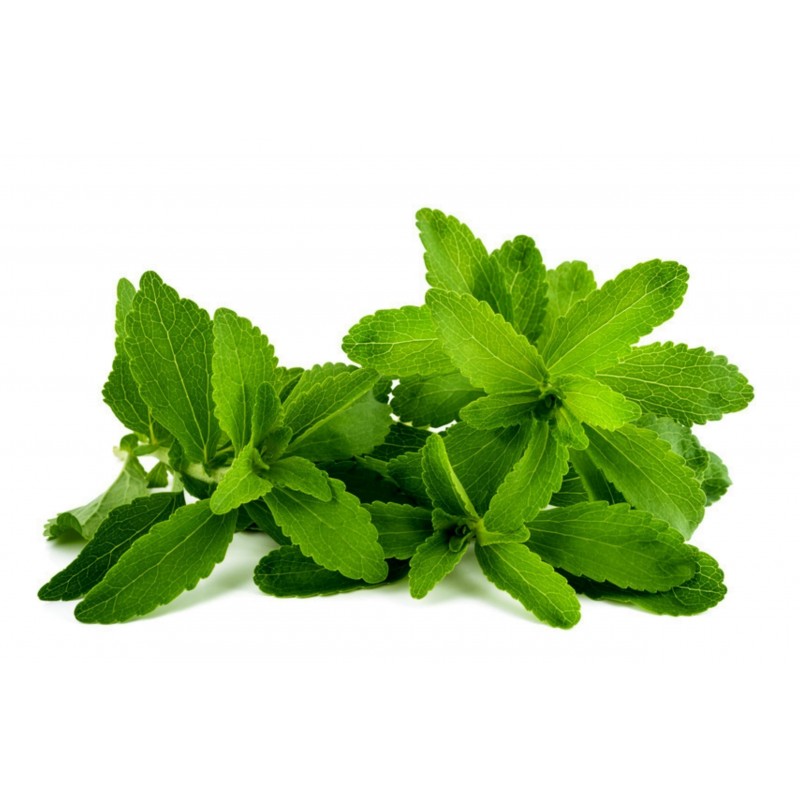
Stevia Seeds (Stevia rebaudiana)
Stevia Seeds - Herb
Price for Package of +-100 (0,06 g) seeds.
Stevia is a genus of about 240 species of herbs and shrubs in the sunflower family (Asteraceae), native to subtropical and tropical regions from western North America to South America. The species Stevia
Stevia Seeds - Herb
Price for Package of +-100 (0,06 g) seeds.
History and use
In 1899, the Swiss botanist Moisés Santiago Bertoni, during his research in eastern Paraguay first described the plant and the sweet taste in detail.[11] Only limited research was conducted on the topic until, in 1931, two French chemists isolated the glycosides that give stevia its sweet taste.[12] These compounds were named stevioside and rebaudioside, and are 250–300 times as sweet as sucrose, heat stable, pH stable, and non-fermentable.
Today, stevia is cultivated and used in food elsewhere in east Asia, including in China (since 1984), Korea, Taiwan, Thailand, and Malaysia. It can also be found in Saint Kitts and Nevis, in parts of South America (Brazil, Colombia, Peru, Paraguay, and Uruguay), and in Israel. China is the world's largest exporter of stevioside.
Folk medicine and research
Sowing Instructions | |
| Propagation: | |
| Pretreat: | 0 |
| Stratification: | 0 |
| Sowing Time: | all year round |
| Sowing Depth: | Needs Light to germinate! Just sprinkle on the surface of the substrate + gently press |
| Sowing Mix: | Coir or sowing mix + sand or perlite |
| Germination temperature: | min. 21 ° C |
| Location: | bright + keep constantly moist not wet |
| Germination Time: | 1-2 weeks |
| Watering: | Water regularly during the growing season |
|
|
|
| Organic Seeds ? | Organic Seeds |
|---|---|
| Organic/natural ? | Organic/Natural: Yes |
| Edible ? | Edible |
| Perennial ? | Perennial plant : Yes |
| Semințe culese manual? | Semințe culese manual |
| Plant is suitable for growing ? | The plant is suitable for growing in a greenhouse The plant is suitable for growing on a balcony-terrace The plant is suitable for outdoors cultivation |
| Suitable for growing in flower pot ? | Suitable for pot: Yes |
| Medicinal Plant ? | Medicinal Plant: Yes |
| Seeds requires light for germination ? | Requires light for germination |


Aprecierea ta pentru recenzie nu a putut fi trimisa
Reclama un comentariu
Raport trimis
Reclamatia tau nu a putut fi trimisa
Scrie-ti recenzia
Recenzia a fost trimisa
Recenzia ta nu a putut fi trimisa
🌍 Livrare Globală din UE
Expediem comenzi la nivel mondial din Uniunea Europeană prin poștă înregistrată cu confirmare de primire.
📦 Urmărirea coletului
Pentru a urmări coletul, autentifică-te în contul tău și accesează secțiunea Istoricul comenzilor > Detalii. Acolo vei găsi numărul de urmărire.
Urmărire internațională: 17Track
Pentru numere de tip RGxxxxxxHR: Posta.hr Tracking
🕒 Notă: Informațiile de urmărire devin disponibile după cel puțin 24 de ore de la expediere.
⚠️ Informații importante
Plata ramburs nu este disponibilă.
Verifică dosarul SPAM / Junk al e-mailului pentru a nu rata notificările.
Contactează-ne doar prin formularul de contact de pe site.
E-mailurile directe nu vor fi procesate.
📱 Număr de telefon obligatoriu
La plasarea comenzii, te rugăm să introduci numărul tău de telefon mobil cu prefixul internațional al țării.
Exemplu: +40 712 345 678
🚚 Condiții de livrare
Pentru coletele înregistrate, este necesară semnătura destinatarului.
Nu comanda dacă:
dorești ca pachetul să fie livrat într-o cutie poștală
nu vei fi acasă pentru a-l prelua
dorești ca pachetul să fie lăsat la un vecin (❌ acest lucru nu este posibil)
📬 Dacă oferi o adresă de tip cutie poștală și coletul se pierde, nu ai dreptul la ramburs.
↩️ Returnarea coletului și reexpediere
Dacă, din orice motiv, coletul este returnat către noi:
Vei fi responsabil pentru costul de retur de 2 €
Și pentru costul reexpedierii
⏱ Întârzieri și urmărire
Dacă urmărirea indică „la expeditor”, înseamnă că este în tranzit.
Contactează oficiul poștal local cu numărul de urmărire pentru informații actualizate.
Nu suntem serviciu poștal – nu putem urmări coletul în numele tău.
Nu ne asumăm responsabilitatea pentru timpii de livrare.
🔍 Putem începe o investigație doar după 30 de zile de la data expedierii.
✈️ Opțiuni de livrare
| Tip livrare | Timp procesare | Asigurare | Posibile întârzieri | Detalii |
|---|---|---|---|---|
| Standard | 7–10 zile lucrătoare | ❌ | 7–14 zile | Cea mai ieftină opțiune |
| Prioritară | 1–7 zile lucrătoare | ❌ | 3–10 zile | Comanda procesată prioritar, dar nu livrată mai rapid |
| Asigurată | 1–7 zile lucrătoare | ✅ | 3–10 zile | Rambursare garantată dacă coletul se pierde (până la 150 €) |
🕒 Timp estimativ de livrare:
În UE: 3–20 zile lucrătoare
Internațional: 5–30 zile lucrătoare
Exemple livrări SUA: 27, 22, 19, 17, 13 zile
💳 Metode de plată
💶 Transfer bancar (SEPA / IBAN / SWIFT-BIC)
În descrierea plății trebuie să menționezi codul comenzii (ex. SGS-19811702).
Dacă nu apare codul, comanda poate întârzia sau fi anulată.
Dacă plata nu este recepționată în 7 zile, comanda va fi anulată automat.
🅿️ PayPal
Acceptăm plăți doar în euro.
Te rugăm să selectezi euro în timpul procesului de plată.
💳 Card bancar
Plata se face pe site-ul nostru: Exotic Seeds Store
Acceptăm: Visa, MasterCard, American Express, Diners Club, Discover, JCB, UnionPay etc.
💡 Clientul suportă toate taxele de tranzacție.
Pentru procesare rapidă, trimite dovada plății.
📅 Observații suplimentare
Nu procesăm comenzi și nu expediem sâmbăta sau duminica.
Verifică întotdeauna anunțurile importante de pe site-ul nostru înainte de a plasa o comandă (ex. sărbători sau condiții speciale).
📫 Important:
Nu trimite mesaje pe adresa noastră de e-mail. Folosește exclusiv formularul de contact disponibil pe site-ul nostru.
Related Products











